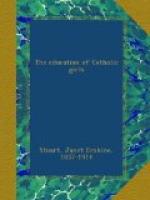supernatural in itself, tells beyond the supernatural
sphere and raises the natural qualities, by self-knowledge,
by truth, by the safeguard of religion against hardness
and isolation and the blindness of pride, even if the
minimum of educational facilities have been at work
to take advantage of these openings for good.
A Catholic child is a child, and keeps a childlike
spirit for life, unless the early training is completely
shipwrecked, and even then there are memories which
are means of recovery, and the way home to the Father’s
house is known. It may be hoped that very many
never leave it, and never lose the sense of being one
of the great family, “of the household of faith.”
They enjoy the freedom of the house, the rights of
children, the ministries of all the graces which belong
to the household, the power of being at home in every
place because the Church is there with its priesthood
and its Sacraments, responsible for its children,
and able to supply the wants of their souls.
It is scarcely possible to find among Catholic children
the inaccessible little bits of flint who are not
brought
up, but bring up their own souls outside the Church—proud
in their isolation, most proud of never yielding inward
obedience or owning themselves in the wrong, and of
being sufficient for themselves. When the grace
of Q-od reaches them and they are admitted into the
Church, one of the most overwhelming experiences is
that of becoming one of a family, for whom there is
some one responsible, the Father of the family whose
authority and love pass through their appointed channels,
down to the least child.
There is no such thing as an orphan child within the
Church, there are possibilities of training and development
which belong to those who have to educate the young
which must appeal particularly to Catholic teachers,
for they know more than others the priceless value
of the children with whom they have to do. Children,
souls, freighted for their voyage through life, vessels
so frail and bound for such a port are worthy of the
devoted care of those who have necessarily a lifelong
influence over them, and the means of using that influence
for their lifelong good ought to be a matter of most
earnest study. Knowledge must come before action,
and first-hand knowledge, acquired by observation,
is worth more than theoretic acquirements; the first
may supply for the second, but not the second for the
first. There are two types of educators of early
childhood which no theory could produce, and indeed
no theory could tell how they are produced, but they
stand unrivalled—one is the English nurse
and the other the Irish. The English nurse is
a being apart, with a profound sense of fitness in
all things, herself the slave of duty; and having certain
ideals transmitted, who can tell how, by an unwritten
traditional code, as to what ought to be, and
a gift of authority by which she secures that these
things shall be, reverence for God, reverence




